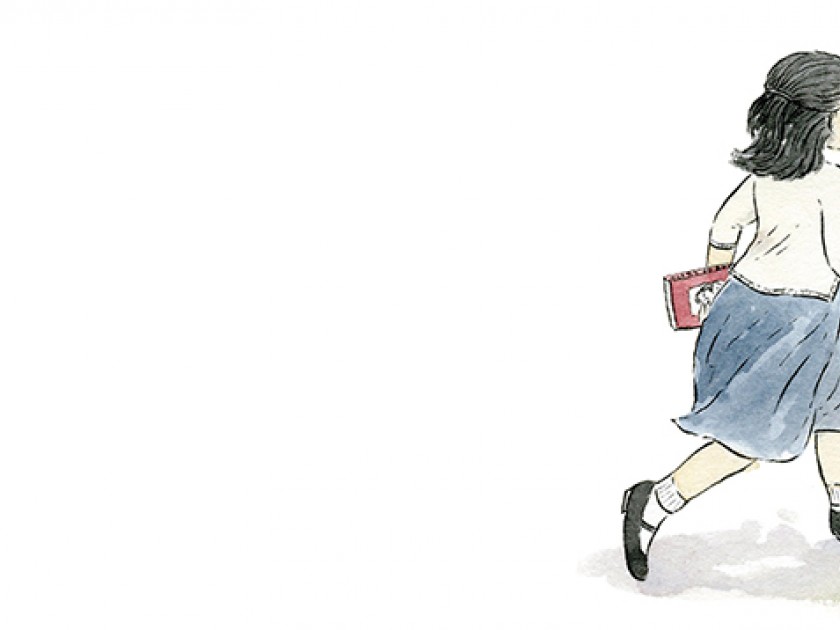
Illustration: Katherine Messenger
Anne Frank’s parents could not have known, when they bought the small, square notebook with its red-and-white checked cover, that this little book would be a present not just for their daughter but for the entire world.
Like many thirteen-year-old girls, Anne eagerly embraced the project of keeping a diary. But unlike so many of them, who abandon the enterprise after a few weeks, she faithfully maintained hers, year after year. Why? Because Anne was a writer:
There is a saying that ‘paper is more patient than man’; it came back to me on one of my slightly melancholy days, while I sat chin in hand, feeling too bored and limp even to make up my mind whether to go out or stay at home. Yes, there is no doubt that paper is patient and as I don’t intend to show this cardboard-covered notebook, bearing the proud name of ‘diary,’ to anyone, unless I find a real friend, boy or girl, probably nobody cares. And now I come to the root of the matter, the reason for my starting a diary: it is that I have no such real friend. (June 20, 1942)
On one hand, Anne’s hope for a “real” friend can be read as a sensitive adolescent’s desire to be seen and heard. Reading this entry with the knowledge of what ultimately happened to Anne and her family imbues it with a great sadness and heartbreaking irony: Anne’s wish to share her innermost thoughts was granted beyond her wildest dreams, as her words have been read by millions of people, over several generations — at the tragic cost of her own premature death.
But there is more to this entry than a teenager’s yearning to be understood. These words also offer us one young girl’s explanation for why she chose to write. They show us a nascent artist’s yearning “to bring out all kinds of things that lie buried deep in my heart,” and they reveal a writer’s faith in pen and paper as the surest medium for expressing the thoughts and feelings of the secret self that she most valued.
Reading Anne Frank’s diary as a kind of “Portrait of the Artist as a Young Woman” is a poignant enterprise. She proves herself to be a great storyteller, as she recounts life in the Annex, using singular descriptions (“[Father] puts on his potato-peeling face”), wry dialogue (“[Mr. Van Daan announces, ‘When this is all over, I’m going to have myself baptized’”), and amusing metaphors (“An elephant’s tread is heard on the stairway. It’s Dussel”). Time and again, I catch glimpses of her sensitivity — her desperation to lift the curtains and look at the moon, the fact that a dark, rainy evening, a gale, “scudding clouds” can hold her “entirely in their power.”
Anne’s artistic temperament also reveals itself when she feels depressed. Her mother admonishes her and advises, “Think of all the misery in the world and be thankful that you are not sharing in it!’” (March 7, 1944). But Anne rejects that cure for melancholy. She finds that, for herself, the key to joy is to dwell in beauty, not sorrow:
I don’t think then of all the misery, but of the beauty that still remains.… I don’t see how Mummy’s idea can be right.… On the contrary, I’ve found that there is always some beauty left — in nature, sunshine, freedom, in yourself; these can all help you.
Anne’s faith in the redeeming power of beauty, even or perhaps especially in the midst of sadness and defeat, oppression, and tragedy, is, to my mind, quintessentially artistic. While the world around her appears to be going mad, Anne clings to beauty as a pillar. She cannot count on anything else; she has lost her home, bombs are being dropped on her head daily, she is grateful to be able to eat even rotten kale, yet beauty remains. When overwhelming darkness and injustice descend upon the world, creating something beautiful may seem insignificant and pointless — but Anne Frank reminds us that that effort may in fact be the most important one of all.
A lamentable and shameful truth about Anne Frank’s story is that the United States had the opportunity to shelter her: in 1938 and again in 1941, the entire Frank family sought to enter this country as refugees. Ultimately, their efforts were futile, because widespread antisemitism and xenophobia led to drastic restrictions on immigration from war-torn Europe. Had the United States not allowed itself to be ruled by fear and distrust, had it welcomed Anne Frank into its borders, she would surely have continued writing, increasing the measure of beauty in the world with every word.
Ursula Werner is a writer and attorney currently living in Washington, DC, with her family. Born in Germany and raised in South Florida, she has practiced law while continuing her creative writing, publishing two books of poetry, In the Silence of the Woodruff (2006) and Rapunzel Revisited (2010). Her first novel, The Good at Heart, was published by Touchstone Books earlier this year.